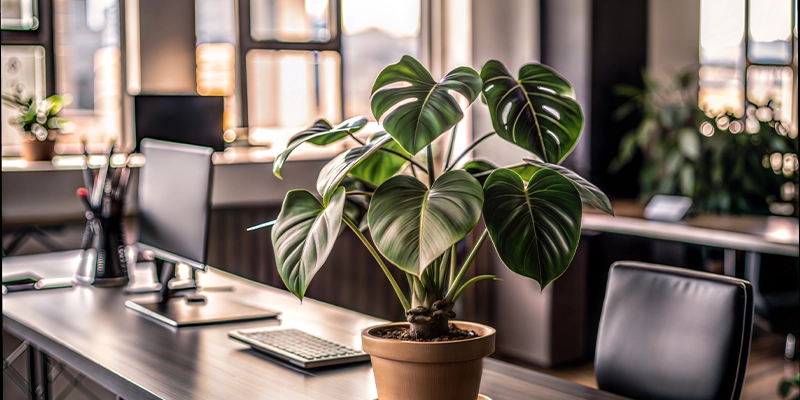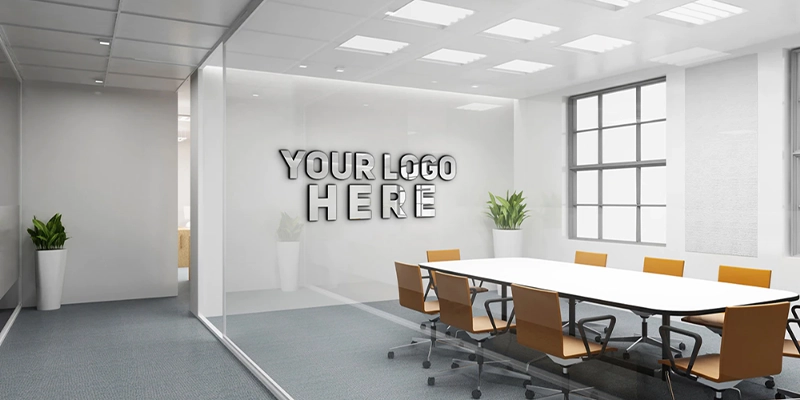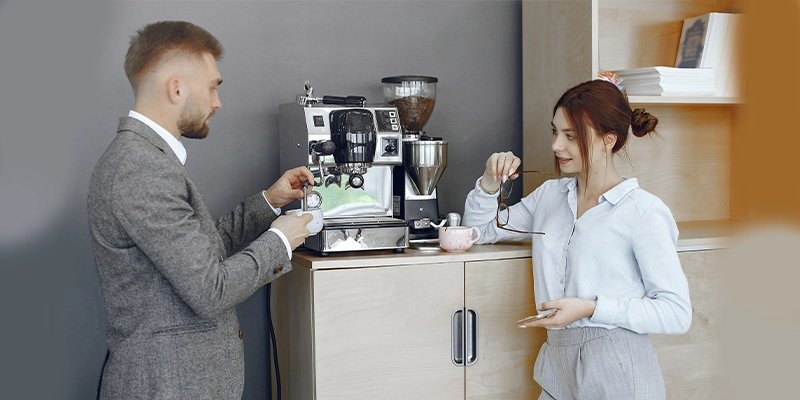Contents
Office design is no longer a secondary consideration for law firms; it has become a key factor in shaping productivity and client perception. Modern lawyer office design transcends traditional aesthetics, serving as a strategic tool to foster collaboration, enhance efficiency, and project professionalism.
This article explores 14 modern lawyer office design ideas that not only optimize functionality but also elevate your firm’s image. Whether you’re looking to enhance team collaboration or create a more client-focused experience, these ideas provide a roadmap for transforming your office into a modern, efficient, and inviting workspace.
Embracing Open and Collaborative Spaces
Modern lawyer office design often departs from traditional closed-door layouts in favor of open and collaborative spaces. These changes aim to foster teamwork and enhance communication while still respecting the privacy needs of legal work.
Open Floor Plans
Shifting to an open floor plan encourages a culture of collaboration among staff. By removing physical barriers, team members can communicate more freely, share ideas, and address issues quickly. This setup is particularly beneficial for teams that require frequent interaction. However, open spaces should be balanced with quiet zones for focused work when needed.
Glass Walls and Partitions
Glass walls and partitions are an excellent solution for firms that need to maintain privacy without compromising a modern aesthetic. They create transparency and openness, giving the office a spacious and welcoming feel. At the same time, soundproofing options ensure confidentiality during sensitive conversations or meetings.
Integrating Advanced Technology
Technology is at the heart of modern lawyer office design, enabling smoother operations and improving employee and client experiences. In a field where reputation and client experience are critical, leveraging technology within your office design can be the factor that makes your firm stand out from competitors.
Smart Meeting Rooms
Equipping meeting rooms with cutting-edge tools such as video conferencing systems, interactive displays, and centralized scheduling software streamlines communication and decision-making processes. These upgrades are significant in an increasingly hybrid work environment, where seamlessly connecting with remote clients or colleagues is a competitive advantage. A tech-enabled meeting room reflects your firm’s commitment to efficiency and professionalism, impressing clients and fostering trust.
Wireless Charging Stations
Modern clients and employees expect convenience in their interactions with technology. Incorporating wireless charging stations into your office design delivers on this expectation while reinforcing your firm’s image as innovative and client-focused. These small touches go a long way in creating an environment that appeals to tech-savvy clients and enhances overall satisfaction.
Prioritizing Ergonomics and Comfort
Modern lawyer office design with the highest satisfaction rate is about creating a workspace that promotes health and well-being. Prioritizing ergonomics and comfort is essential for fostering productivity and maintaining employee satisfaction, especially in a profession where long hours at a desk are common.
Adjustable Standing Desks
Adjustable standing desks allow employees to switch between sitting and standing throughout the day. An adjustable desk for a lawyer’s office design helps reduce fatigue and promotes better posture and overall health. Adjustable desks cater to individual preferences and create a more adaptable work environment, boosting focus and productivity.
Ergonomic Chairs
A comfortable, ergonomic office environment reflects a commitment to the team’s well-being. It can also enhance your ability to attract and retain top talent in a competitive legal market. By implementing comfort in your office design, you create a space where employees feel valued, and clients sense professionalism.
Sustainable and Eco-Friendly Design
Sustainability is becoming a key focus in modern lawyer office design, not only for its environmental benefits but also as a statement of corporate responsibility.
Incorporating eco-friendly elements into your workspace can reduce operational costs, improve employee well-being, and appeal to environmentally conscious clients.
Energy-Efficient Lighting
Switching to LED lighting and maximizing natural light are simple yet effective ways to make your office more sustainable. LED lights consume significantly less energy and have a longer lifespan, while natural light improves mood and productivity. Strategically placed windows and skylights can brighten the office and reduce dependence on artificial lighting.
Indoor Greenery
Bringing plants into the office enhances air quality, reduces stress, and creates a more welcoming atmosphere. Options like succulents, ferns, and low-maintenance greenery work well in professional spaces, adding a touch of nature that balances the formal environment. Living walls or potted plants strategically placed throughout the office can significantly impact the office without requiring extensive maintenance.
Adopting sustainable design practices not only reduces your firm’s environmental footprint but also enhances your appeal to eco-conscious clients and employees. For instance, integrating a recycling program for office waste, opting for furniture made from sustainable materials, and installing energy-efficient HVAC systems are practical steps that showcase your commitment to sustainability. These tangible efforts can improve your firm’s reputation, strengthen client relationships, and demonstrate that you are aligned with modern values. A workspace that actively supports green initiatives positions your firm as innovative, responsible, and forward-thinking.
Incorporating Brand Identity
Modern lawyer office design presents a strategic opportunity to reinforce your firm’s brand and values. Beyond aesthetics, a well-designed office conveys professionalism, fosters trust with clients, and instills pride among employees. By integrating thoughtful design elements that reflect your firm’s unique identity, your workspace becomes an extension of your brand, enhancing how clients and employees experience your firm.
Customized Decor
Incorporating your firm’s branding into the office design helps create a sense of identity and cohesion. This branding identity could include using your brand’s colors in furniture, walls, or accents and incorporating custom artwork or design elements that reflect your firm’s mission. For example, displaying legal motifs or visuals tied to your practice areas can make the space feel uniquely yours while resonating with clients.
Displaying Awards and Achievements
A dedicated space to showcase awards, certifications, or significant case milestones demonstrates your firm’s credibility and accomplishments. This Display could be a feature wall in the reception area or an understated display in meeting rooms. These elements subtly communicate your expertise and instill confidence in clients without saying a word.
Enhancing Client Experience
Modern lawyer office design is pivotal in shaping how clients perceive your firm. From the moment they step through the door, the design and layout of your office should communicate professionalism, trustworthiness, and attention to detail. Prioritizing the client experience through thoughtful design leaves a positive impression and reinforces their confidence in your ability to handle their legal needs.
Reception Areas
The reception area serves as the gateway to your firm and sets the tone for client interactions. Comfortable seating, contemporary decor, and a welcoming ambiance create an environment that puts clients at ease. Adding sophisticated touches like branded artwork or a polished information display ensures the space feels professional and inviting.
Beverage Stations
A small yet meaningful addition, a beverage station offering coffee, tea, or water elevates the client experience. This simple gesture shows that your firm values their comfort, creating a hospitable atmosphere that helps clients feel cared for before meetings or consultations.
Flexible Workspaces
Flexibility is key in modern lawyer office design, providing adaptable spaces for focused work, collaboration, and diverse working styles. These versatile areas are great for improving efficiency and supporting productivity.
Quiet Zones
Dedicated quiet zones are essential for lawyer offices that require deep focus and concentration. These areas minimize distractions, allowing attorneys to review case files, draft documents, or prepare for court proceedings without interruptions. Strategically located and soundproofed, quiet zones enhance the ability to deliver high-quality work.
Collaboration Hubs
In contrast to quiet zones, collaboration hubs are office designs that foster teamwork and brainstorming. These spaces typically feature comfortable seating, whiteboards, and technology that supports group discussions and idea-sharing. They encourage a culture of collaboration, making it easier for teams to work together on complex cases or strategy development.
Integrating Practice Management Solutions
Modern lawyer office design is complemented by technology that enhances efficiency and reduces operational friction. Incorporating legal practice management solutions into your office’s infrastructure can streamline workflows, improve communication, and optimize how your team manages cases and clients.
● RunSensible: Elevating Office Efficiency
RunSensible simplifies day-to-day tasks such as document management, appointment scheduling, and client communication. This automation frees up valuable time, allowing your team to focus on client service and case strategy. By reducing manual workloads, improving efficiency, and eliminating the need for excessive storage, RunSensible can save your firm time and money.
Final Thoughts
Modern office design is more than a trend—it’s an investment in your law firm’s success. Thoughtful design choices can enhance productivity, foster collaboration, and create a welcoming environment that strengthens client trust. From integrating advanced technology to prioritizing comfort, sustainability, and branding, these ideas ensure your workspace reflects your firm’s professionalism and forward-thinking approach.
Adopting these design principles isn’t just about aesthetics; it’s about positioning your firm for long-term growth and sustainability in a competitive industry. Creating an office that supports efficiency, showcases your brand, and improves client interactions will set your firm apart as innovative and client-centered.
Take the first step toward transforming your office into a modern, functional, and inspiring space. By implementing these ideas, you’ll elevate your firm’s environment and gain a strategic advantage that resonates with clients and employees.
Transform your law firm’s office into a modern, efficient, and client-focused space. Enhance your environment and streamline your operations with RunSensible. From digital document management to advanced communication tools, RunSensible equips your firm with the technology needed to stay competitive and deliver exceptional service.
FAQs:
- Why is modern office design important for law firms?
Modern office design is crucial for creating a functional, professional, and client-focused environment. It improves productivity, enhances collaboration, and helps build trust with clients by projecting an image of innovation and professionalism.
- How can office design improve client experience?
A well-designed office creates a welcoming and comfortable atmosphere for clients. Features like luxurious reception areas, beverage stations, and clear branding help clients feel valued and confident in your firm’s capabilities, leaving a positive and lasting impression.
- What role does technology play in office design?
Technology is central to modern office design. Smart meeting rooms, wireless charging stations, and integrated practice management tools like RunSensible streamline operations and improve client communication. These features make your firm more efficient and showcase a forward-thinking approach.
- How can law firms balance open, collaborative office spaces with the need for strict confidentiality?
- Use Soundproof Partitions: Install glass walls or acoustic panels for privacy while maintaining openness.
- Adopt Modular Layouts: Use movable furniture or dividers to create adaptable spaces.
- Create Confidential Zones: Add private booths or quiet areas for sensitive discussions.
- Implement Controlled Access: Reserve secure rooms for confidential meetings and casework.
- Leverage Privacy Technology: Use encrypted communication tools and sound-masking systems.
These strategies maintain collaboration while protecting sensitive information.
- How can law firms adapt their office design for hybrid and remote work models while maintaining team cohesion and productivity?
Law firms can:
- Use flexible workstations for in-office employees.
- Equip meeting rooms with video conferencing and shared digital tools.
- Design hybrid-friendly layouts with spaces for both in-person and virtual collaboration.
- Ensure secure remote access to files and communication platforms.
- Foster team connectivity with shared lounges or collaboration hubs.
Disclaimer: The content provided on this blog is for informational purposes only and does not constitute legal, financial, or professional advice.




















